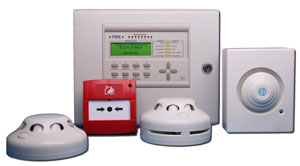Fire Alarm System

Main Features:
- Supports 2 wire international standard smoke detectors.
- Facility to attach speech dialer
- Cabinet closed with a lock and key to restrict the access
- Common tamper led for open or short in any zone
- Panel can be programmed by a user code with user programmable 3-7 digit code
- Panel can be armed or disarmed through code or a dedicated key
- Any zone can be omitted
- Manual call points can be operated even when some detectors have been removed
- 12 event fire memory log with non-volatile memory
- Sounders start automatically when fire is detected and can be programmed from 2 to 20 minutes
- Single dedicated key to arm the panel and disarm the panel
- Single dedicated key to manually start sounders and switch off the sounders
- Single dedicated key for zone led test and for drill exercise
- Two sounder outputs, each can switch 1 amp
- Higher power sounders can be attached through an inbuilt relay
- Battery space provided within the panel with plug in connectors
Fire Alarm and Detection Systems Design
One of the most critical parts of any fire alarm installation is the design stage. If this is not carried out correctly you could have as a minimum a system that does not comply with the British Standards maybe giving out false alarms and at worse a potentially life threatening system that does not detect correctly or not at all. The British Fire Consortium has a requirement that any member company must have sat recognised training in Fire Alarm designing.
System Installation
The installation of your fire alarm system must not only comply with BS5839 but also the 17th Edition Wiring Regulations BS7671. The onus is on the responsible person to ensure your contractors or Installers are competent in both aspects of installation. Installation engineer must ensure the alarm system is fitted in accordance with the plans/ design specification.
Commissioning
The final step of the fire alarm and detection system installation, Commissioning is possibly the most important step in the installation of the fire alarm system; this is because they are the person who checks the whole system and sign's it as safe and fit for purpose.
First they check it is fitted as per the design specifications and the as-fitted drawings and that the system complies with BS5839 and wiring is to the wiring regulations and safe to use.
Once they are satisfied the system is as it should be the commissioner will then test every device, detector and sounder etc on the system including checking the system performs as it should in various fault scenarios.
If the commissioner is not happy with the system he will give a list of works to be done before a re-test and will not pass it or certificate it.
The British Fire Consortium has a requirement that any member company must have sat recognised training in Fire Alarm Commissioning.
Maintenance
All fire alarm and detection systems should be maintain by a competent person or company, in the Government guide books on the Regulatory Reform (Fire Safety) Order 2005, It strongly recommends that your fire alarm should be maintained to BS5839-1 or 6 and that it should be maintained as a minimum of every Six months more frequently if your site is classes as a high risk building or you have the possibility of vandalism etc of your fire system.
The British Fire Consortium has a requirement that any member company must have sat recognised training in Fire Alarm maintenance.
Competency and Training
All fire alarm engineers must be Competent in the field of work they carry out, the British Standards states:
Competent person
Person with the necessary training and experience, and with access to the requisite tools, equipment and Information, and capable of carrying out a defined task














connect & share
stay social with The Raim Security